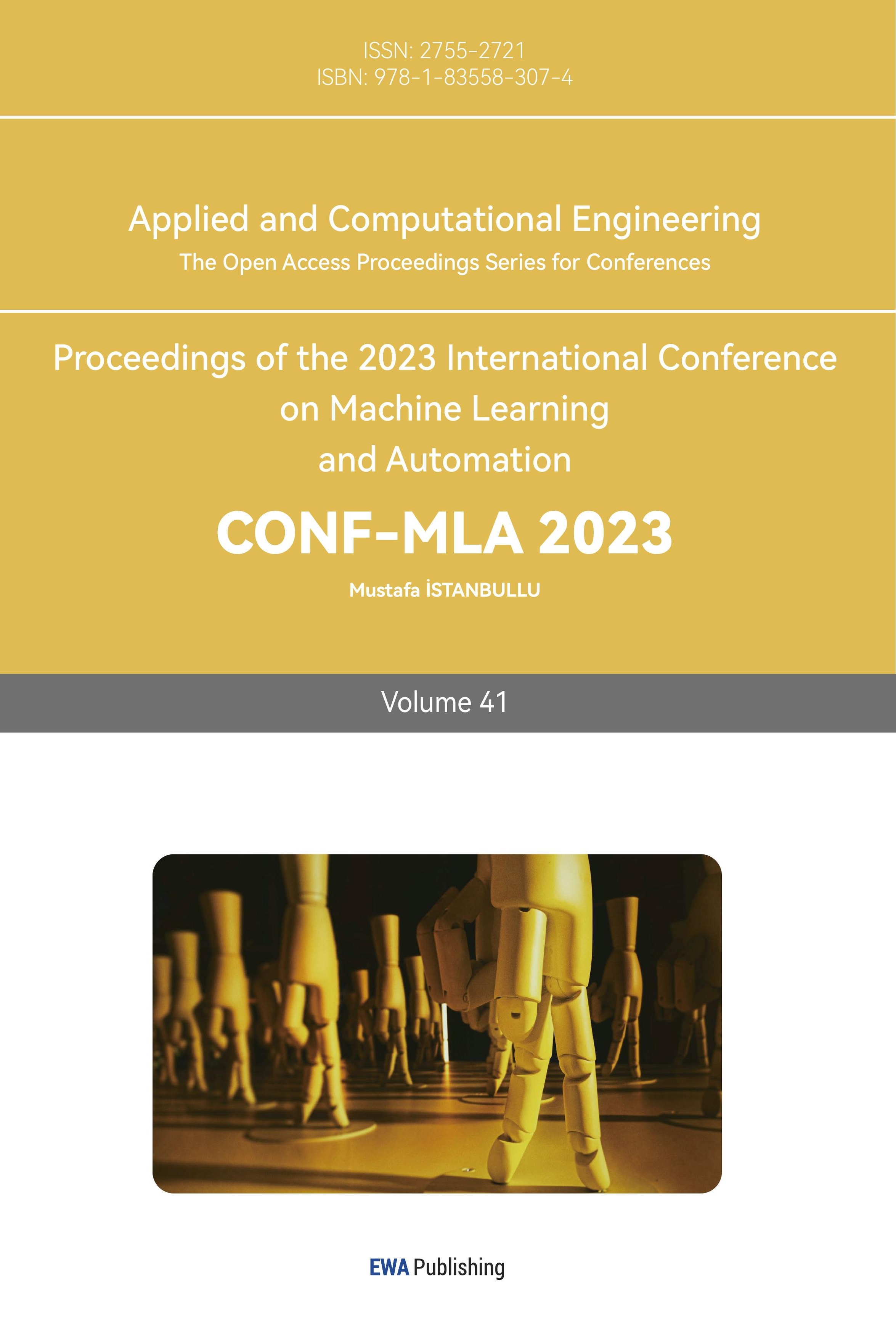References
[1]. Jain, S., jagtap, V. and Pise, N. (2015) ‘Computer Aided Melanoma Skin Cancer Detection Using Image Processing’, Procedia Computer Science, 48, pp. 735–740. Available at: https://doi.org/10.1016/j.procs.2015.04.209.
[2]. Cabria, I. and Gondra, I. (2017) ‘MRI segmentation fusion for brain tumor detection’, Information Fusion, 36, pp. 1–9. Available at: https://doi.org/10.1016/j.inffus.2016.10.003.
[3]. Silva, W. et al. (2022) ‘Computer-aided diagnosis through medical image retrieval in radiology’, Scientific Reports, 12(1), p. 20732. Available at: https://doi.org/10.1038/s41598-022-25027-2.
[4]. K, A. et al. (2022) ‘A Modified LBP Operator-Based Optimized Fuzzy Art Map Medical Image Retrieval System for Disease Diagnosis and Prediction’, Biomedicines, 10(10), p. 2438. Available at: https://doi.org/10.3390/biomedicines10102438.
[5]. Razzak, M.I., Naz, S. and Zaib, A. (2018) ‘Deep Learning for Medical Image Processing: Overview, Challenges and the Future’, in N. Dey, A.S. Ashour, and S. Borra (eds) Classification in BioApps: Automation of Decision Making. Cham: Springer International Publishing (Lecture Notes in Computational Vision and Biomechanics), pp. 323–350. Available at: https://doi.org/10.1007/978-3-319-65981-7_12.
[6]. Lin, Y. et al. (2023) ‘Imaging-Navigated Surgery’, in Z. Liu (ed.) Visualized Medicine: Emerging Techniques and DevelopinFrontiers. Singapore: Springer Nature (Advances in Experimental Medicine and Biology), pp. 87–106. Available at: https://doi.org/10.1007/978-981-32-9902-3_5.
[7]. Tang, X. et al. (2022) ‘Vision-Based Automated Control of Magnetic Microrobots’, Micromachines, 13(2), p. 337. Available at: https://doi.org/10.3390/mi13020337.
[8]. Tang, Y., Qiu, J. and Gao, M. (2022) ‘Fuzzy Medical Computer Vision Image Restoration and Visual Application’, Computational and Mathematical Methods in Medicine, 2022, p. 6454550. Available at: https://doi.org/10.1155/2022/6454550.
[9]. J, O. et al. (2021) ‘What is new in computer vision and artificial intelligence in medical image analysis applications’, Quantitative imaging in medicine and surgery, 11(8). Available at: https://doi.org/10.21037/qims-20-1151.
Cite this article
Zuo,L. (2024). Application of deep-learning based computer vision in medical image analysis. Applied and Computational Engineering,41,259-262.
Data availability
The datasets used and/or analyzed during the current study will be available from the authors upon reasonable request.
Disclaimer/Publisher's Note
The statements, opinions and data contained in all publications are solely those of the individual author(s) and contributor(s) and not of EWA Publishing and/or the editor(s). EWA Publishing and/or the editor(s) disclaim responsibility for any injury to people or property resulting from any ideas, methods, instructions or products referred to in the content.
About volume
Volume title: Proceedings of the 2023 International Conference on Machine Learning and Automation
© 2024 by the author(s). Licensee EWA Publishing, Oxford, UK. This article is an open access article distributed under the terms and
conditions of the Creative Commons Attribution (CC BY) license. Authors who
publish this series agree to the following terms:
1. Authors retain copyright and grant the series right of first publication with the work simultaneously licensed under a Creative Commons
Attribution License that allows others to share the work with an acknowledgment of the work's authorship and initial publication in this
series.
2. Authors are able to enter into separate, additional contractual arrangements for the non-exclusive distribution of the series's published
version of the work (e.g., post it to an institutional repository or publish it in a book), with an acknowledgment of its initial
publication in this series.
3. Authors are permitted and encouraged to post their work online (e.g., in institutional repositories or on their website) prior to and
during the submission process, as it can lead to productive exchanges, as well as earlier and greater citation of published work (See
Open access policy for details).
References
[1]. Jain, S., jagtap, V. and Pise, N. (2015) ‘Computer Aided Melanoma Skin Cancer Detection Using Image Processing’, Procedia Computer Science, 48, pp. 735–740. Available at: https://doi.org/10.1016/j.procs.2015.04.209.
[2]. Cabria, I. and Gondra, I. (2017) ‘MRI segmentation fusion for brain tumor detection’, Information Fusion, 36, pp. 1–9. Available at: https://doi.org/10.1016/j.inffus.2016.10.003.
[3]. Silva, W. et al. (2022) ‘Computer-aided diagnosis through medical image retrieval in radiology’, Scientific Reports, 12(1), p. 20732. Available at: https://doi.org/10.1038/s41598-022-25027-2.
[4]. K, A. et al. (2022) ‘A Modified LBP Operator-Based Optimized Fuzzy Art Map Medical Image Retrieval System for Disease Diagnosis and Prediction’, Biomedicines, 10(10), p. 2438. Available at: https://doi.org/10.3390/biomedicines10102438.
[5]. Razzak, M.I., Naz, S. and Zaib, A. (2018) ‘Deep Learning for Medical Image Processing: Overview, Challenges and the Future’, in N. Dey, A.S. Ashour, and S. Borra (eds) Classification in BioApps: Automation of Decision Making. Cham: Springer International Publishing (Lecture Notes in Computational Vision and Biomechanics), pp. 323–350. Available at: https://doi.org/10.1007/978-3-319-65981-7_12.
[6]. Lin, Y. et al. (2023) ‘Imaging-Navigated Surgery’, in Z. Liu (ed.) Visualized Medicine: Emerging Techniques and DevelopinFrontiers. Singapore: Springer Nature (Advances in Experimental Medicine and Biology), pp. 87–106. Available at: https://doi.org/10.1007/978-981-32-9902-3_5.
[7]. Tang, X. et al. (2022) ‘Vision-Based Automated Control of Magnetic Microrobots’, Micromachines, 13(2), p. 337. Available at: https://doi.org/10.3390/mi13020337.
[8]. Tang, Y., Qiu, J. and Gao, M. (2022) ‘Fuzzy Medical Computer Vision Image Restoration and Visual Application’, Computational and Mathematical Methods in Medicine, 2022, p. 6454550. Available at: https://doi.org/10.1155/2022/6454550.
[9]. J, O. et al. (2021) ‘What is new in computer vision and artificial intelligence in medical image analysis applications’, Quantitative imaging in medicine and surgery, 11(8). Available at: https://doi.org/10.21037/qims-20-1151.









